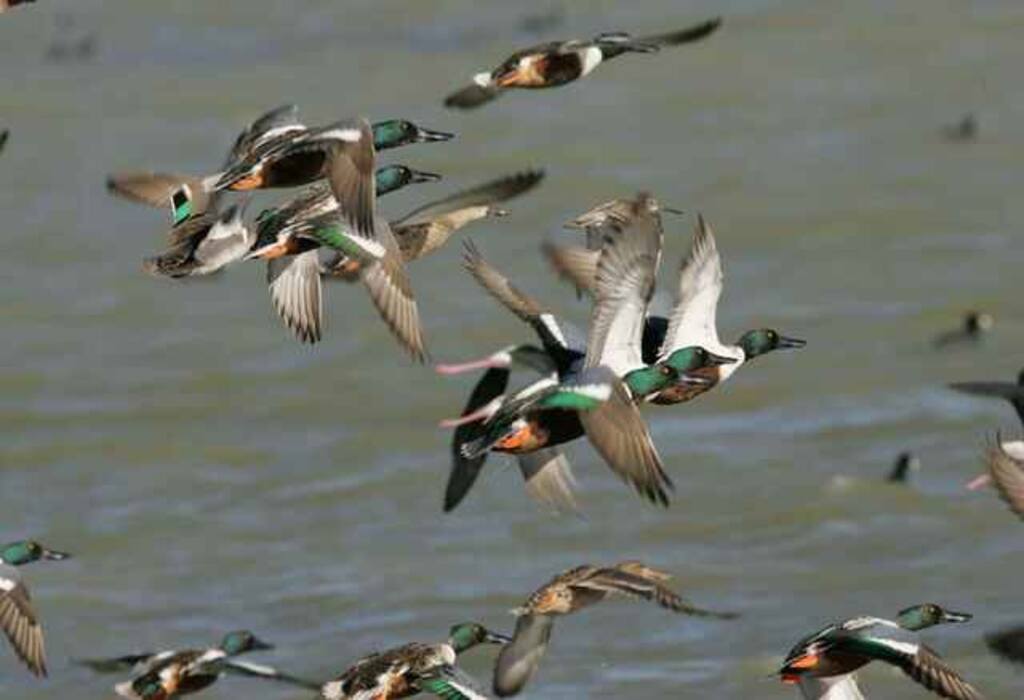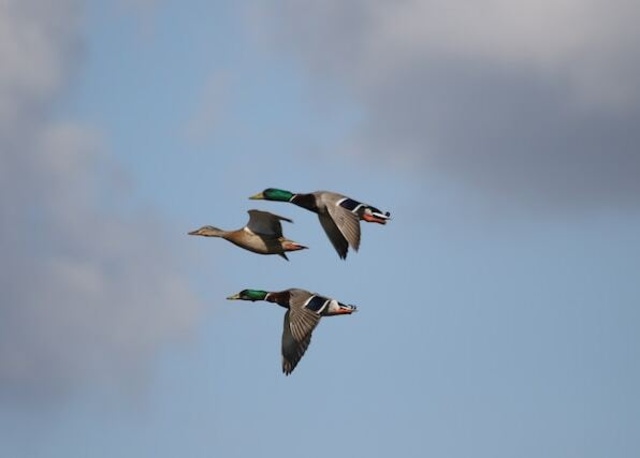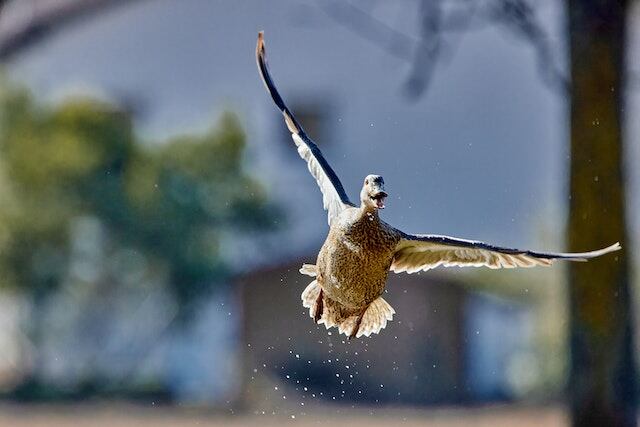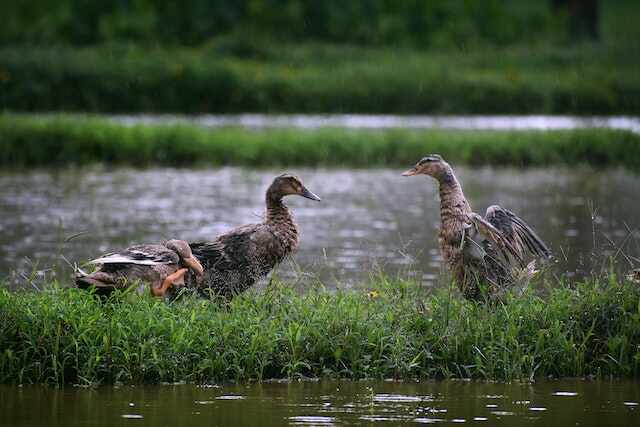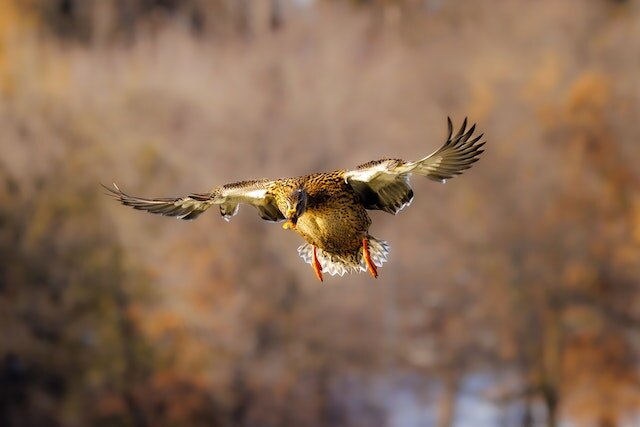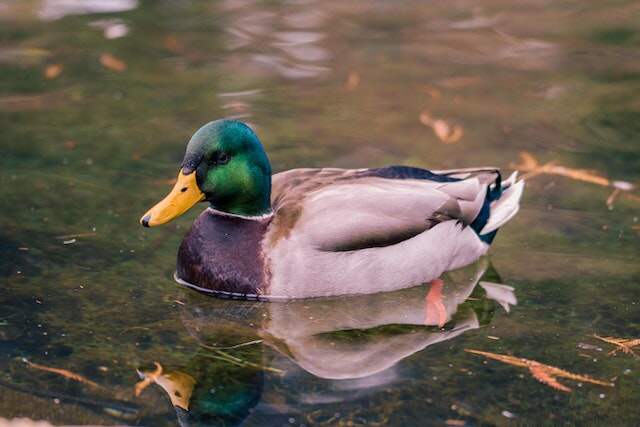Looking up at the sky, you might spot a flock of ducks soaring high above you, and wonder – do ducks migrate? The short answer is yes, and they do it for a variety of reasons.
But the real question is, what makes their migration so fascinating and worth learning about?
From incredible distances covered to unique migration patterns, this article will take you on a journey of discovery about the world of duck migration. Get ready to quack up with some fascinating facts!
Table of Contents
- 1 Introduction to Duck Migration
- 2 Why Do Ducks Migrate?
- 3 The Different Types of Duck Migration
- 4 Timing of Duck Migration
- 5 Duck Migration Patterns and Routes
- 6 Factors That Affect Duck Migration
- 7 Conservation Issues Related to Duck Migration
- 8 How to Observe and Track Duck Migration
- 9 Interesting Facts About Duck Migration
- 10 Conclusion: Understanding the Importance of Duck Migration
- 11 Frequently Asked Questions
- 11.1 What is the lifespan of a duck?
- 11.2 What are the benefits of duck migration for their overall health and well-being?
- 11.3 How do ducks communicate with each other during migration?
- 11.4 What is the impact of climate change on duck migration patterns?
- 11.5 How do ducks know where to migrate to each year?
- 12 Conclusion
- 13 Author
Introduction to Duck Migration
As the seasons change, these feathered travelers take to the skies, journeying across vast distances in search of warmer weather and plentiful food sources. This is called duck migration, and it is a natural phenomenon that occurs every year.
Duck migration patterns are unique to each species, with some ducks traveling only short distances while others embark on journeys spanning thousands of miles.
There are several reasons why ducks migrate. One of the primary reasons is to escape harsh winter conditions.
As temperatures drop and water sources freeze, ducks are forced to search for new habitats with enough food and water to survive.
Additionally, some ducks migrate to breed in the spring, returning to their nesting grounds after spending the winter months in warmer climates. Timing of duck migration varies depending on the species and location.
In general, ducks migrate during the fall and spring months, with some species starting as early as August and others not beginning their journey until November.
The distance covered by migrating ducks can also vary widely, with some ducks traveling only a few hundred miles and others crossing entire continents.
In summary, duck migration is a fascinating natural phenomenon that occurs every year. The reasons why ducks migrate are varied, but all relate to the need for food, water, and shelter.
Understanding the timing and distance of duck migration can help us better appreciate the remarkable journeys these birds undertake each year.
Why Do Ducks Migrate?
You may be curious as to the reasons behind the seasonal journey taken by these feathered creatures. So, why do ducks migrate?
There are a few reasons why ducks undertake this long and arduous journey. One reason is to find a suitable breeding ground. Ducks are known to migrate to areas where they can find a mate and lay their eggs.
During the winter, the cold weather makes it difficult for ducks to find food, so they migrate to warmer areas where they can find food easily.
Ducks usually start their migration during fall when the weather begins to get colder. They start their journey towards the south, where they can find a warmer climate and abundant food sources.
They usually end their migration when the weather starts to get warmer, typically during spring. The distance covered by migrating ducks can vary depending on their species.
For example, some types of ducks can cover a distance of up to 1,500 miles during their migration. Ducks have a remarkable ability to navigate during migration.
They use several cues to find their way, such as the position of the sun, the stars, and the earth’s magnetic field.
They also have an excellent memory that helps them remember the routes they took during their previous migration.
Ducks also fly in a V-formation, which helps them conserve energy and makes it easier for them to navigate through the air.
All these factors help ducks during their migration, ensuring that they reach their destination safely and on time.
| Reasons for Migration | Examples |
|---|---|
| Breeding | Ducks migrate to mate and lay eggs. |
| Food | Ducks migrate to find better food sources. |
| Weather | Ducks migrate to avoid harsh winter conditions. |
| Nesting | Ducks migrate to find suitable nesting sites. |
The Different Types of Duck Migration
Learn about the different types of duck migration and discover that some species can cover over 10,000 miles in a single journey!
Not all ducks migrate, but those that do have different types of migration patterns. For instance, some ducks migrate over long distances while others cover short distances.
The types of ducks that migrate include dabbling ducks, diving ducks, and sea ducks. Dabbling ducks are the most common, and they include mallards, pintails, and teal.
Diving ducks like canvasbacks and redhead ducks migrate from their breeding grounds in Canada to the United States during winter.
Sea ducks such as eiders and scoters migrate over long distances and are often found in the Atlantic Ocean.
The reasons why ducks migrate vary depending on the species. Some ducks migrate to breed and raise their young in the north during the summer, while others migrate to warmer places during the winter months.
Migrating ducks face various challenges, including harsh weather conditions and predators. Despite these challenges, ducks continue to migrate year after year, covering thousands of miles in their journey.
| Types of Migration | Description |
|---|---|
| Altitudinal Migration | Ducks move to different elevations within the same region. |
| Latitudinal Migration | Ducks move to different latitudes in response to changing seasons. |
| Nomadic Migration | Ducks move in search of better feeding grounds. |
| Elevational Migration | Ducks move up and down mountains in response to changing temperatures. |
Timing of Duck Migration
Watching ducks fly across the sky during their migration is a sight to behold, especially when you consider the different timing patterns of their journeys.
There are two distinct duck migration patterns: one for the spring breeding season and another for the fall migration to wintering grounds.
The timing of duck migration is dependent on various factors, including the availability of food and water, day length, and temperature changes. Typically, ducks migrate at night and rest during the day.
The duration and distance of their migration vary depending on the species and their breeding and wintering grounds. Some ducks travel over 3,000 miles from their breeding grounds in the Arctic to their wintering grounds in the southern United States, Mexico, Central, and South America.
Others, such as the mallard, breed in northern regions and migrate only a few hundred miles south to spend the winter months. The impact of climate change on duck migration is an ongoing concern.
Changes in temperature and precipitation patterns can affect the availability of food and water, and alter the timing of seasonal events such as flowering and insect hatches.
This can have consequences for the ducks’ breeding success and survival, as well as their migration patterns.
Understanding the timing and reasons for duck migration is crucial for their conservation and management, especially in the face of climate change.
| Season | Timing |
|---|---|
| Fall | Begins in September and peaks in November. |
| Winter | Ducks may migrate south during the winter months. |
| Spring | Begins in February and peaks in April. |
| Summer | Ducks may remain in their breeding areas during the summer months. |
Duck Migration Patterns and Routes
You might be surprised to discover that the distance and route of a duck’s migration varies greatly depending on its species and breeding and wintering grounds.
Generally, ducks migrate to warmer areas during the winter to find food and breeding grounds. Some species of ducks only fly short distances, while others may travel thousands of miles.
For example, the mallard duck, one of the most common species, typically migrates around 1,000 miles. Duck migration patterns are influenced by a variety of factors.
One of the most important is the availability of food. As temperatures drop, many areas experience a shortage of food, which forces ducks to migrate to find a new source.
Additionally, ducks may migrate to areas with more favorable breeding grounds.
Some species of ducks, such as the Pintail and Scaup, migrate from their breeding grounds in Alaska and Canada all the way to the Southern United States and Mexico.
Do ducks fly south for the winter? In general, yes, they do. But not all species of ducks migrate to the same location.
Some species, like the wood duck, may only migrate a short distance, while others, like the eider duck, may travel thousands of miles.
Overall, the migration routes of ducks can be complex and varied, and they are influenced by a variety of factors.
| Species | Migration Routes |
|---|---|
| Mallard | From the Arctic to the southern U.S. and Mexico. |
| Black Ducks | From eastern Canada to the southeastern U.S. |
| Pintail | From Alaska to California and Mexico. |
| Teal | From Canada to the southern U.S. and Mexico. |
Factors That Affect Duck Migration
Do ducks migrate? Absolutely. In fact, duck migration patterns and routes are well-documented. But what are the reasons for duck migration, and what factors influence their decisions? Let’s explore.
The timing of duck migration is largely tied to food availability and breeding cycles. As winter approaches and food becomes scarce, ducks will migrate to more abundant areas.
Similarly, in the spring and summer, ducks will migrate to breeding grounds where food is plentiful and conditions are ideal for raising young.
Habitat and migration of ducks are closely linked, as they require specific food sources and water conditions to survive.
Factors such as climate change, pollution, and habitat loss can disrupt migration patterns and put duck populations at risk.
Other factors that influence duck migration include weather conditions and instinctual behavior. Ducks are sensitive to changes in temperature, wind patterns, and precipitation.
They may also be guided by a genetic instinct to follow certain migration patterns passed down from previous generations.
As humans continue to impact the environment, it’s important to monitor and protect duck populations to ensure healthy migration patterns for years to come.
| Factor | Description |
|---|---|
| Food Availability | Ducks will migrate to find better food sources. |
| Weather Patterns | Changes in weather can alter migration patterns. |
| Breeding Habits | Migratory birds often migrate to breed. |
| Predator Threats | Migration routes may be altered to avoid predators. |
Conservation Issues Related to Duck Migration
Conservation issues related to duck migration include habitat loss. It is estimated that over 50% of wetlands in the United States have been destroyed or degraded.
Wetlands are essential for ducks during their migration, as they provide food, shelter, and breeding grounds.
As a result of habitat loss, ducks are forced to adapt to new environments, which can negatively impact their survival rates.
Conservation efforts for migrating ducks are crucial to their survival, as they depend on these habitats to complete their annual journey.
Reasons for duck migration include breeding, food availability, and weather patterns. Ducks typically migrate in search of better breeding grounds and food sources, as well as to avoid harsh weather conditions.
However, challenges faced by migrating ducks are increasing due to climate change and human activities such as hunting and pollution.
Endangered duck species are particularly vulnerable to these threats, making conservation efforts even more critical.
To protect migrating ducks, conservationists are working to restore and protect wetlands, reduce hunting pressure, and regulate pollution.
Additionally, education and awareness campaigns are essential to help people understand the importance of wetlands and the need to protect them.
By implementing effective conservation measures, we can ensure that ducks will continue to migrate successfully for generations to come.
| Issue | Description |
|---|---|
| Habitat Loss | Destruction of wetland habitats reduces suitable breeding and feeding grounds. |
| Hunting | Overhunting can lead to a decline in duck populations. |
| Pollution | Chemical and oil spills can harm duck populations and their habitats. |
| Climate Change | Changes in weather patterns can affect migration routes and breeding habits. |
How to Observe and Track Duck Migration
Let’s explore how to observe and track the thrilling annual journey of these feathered fliers! Duck migration patterns vary depending on the species, but most ducks migrate south for the winter and return north for breeding season in the spring. However, not all duck species migrate.
For example, the mallard duck is known to be partially migratory, meaning that some individuals will migrate while others will not.
When do ducks start and end migration? Well, this depends on the species and location. Generally, ducks start their migration in the fall when temperatures begin to drop and food sources become scarce.
They will then return to their breeding grounds in the spring, when food and nesting opportunities are abundant.
Conservation efforts for migratory ducks are important to ensure that these birds have the necessary resources to complete their journey and thrive in their habitats.
So, how do researchers track duck migration? Here are some ways to observe and track duck migration:
- Using satellite telemetry to track tagged birds’ movements
- Conducting surveys of migrating ducks, either by ground or air
- Utilizing bird banding and recapture data to study migration patterns
- Monitoring weather patterns to predict migration timing and routes
- Collecting data on food availability and habitat use along migration routes
Observing and tracking duck migration can be a thrilling experience. By understanding migration patterns and conservation efforts, we can help protect these amazing birds and ensure their survival for generations to come.
| Method | Description |
|---|---|
| Bird Watching | Observing ducks in their natural habitats with binoculars or telescopes. |
| Citizen Science | Participating in programs that track and monitor duck populations. |
| Radio-Telemetry | Using radio signals to track the movements of individual ducks. |
| Banding | Placing metal bands on duck legs to track their movements. |
Interesting Facts About Duck Migration
Get ready to be amazed by some fascinating facts about the incredible journey these feathered fliers undertake each year!
Ducks are one of the most migratory birds in the world, and they fly thousands of miles each year to reach their breeding and wintering grounds.
They follow specific duck migration patterns that are influenced by various factors such as food availability, climate, and breeding behavior.
One of the main reasons for duck migration is to find food and breeding grounds. Ducks fly to different locations depending on the season to find the best food sources and suitable habitats for breeding.
The timing of duck migration differs depending on the species, but most ducks migrate during the fall and spring seasons.
During migration, ducks can fly at an incredible speed of up to 50 miles per hour, covering a distance of over 1,000 miles in a single day.
Ducks follow specific migration routes, which are determined by their breeding and wintering locations. These routes can be thousands of miles long and can take several weeks or even months to complete.
Some ducks fly across entire continents, while others fly shorter distances. The distance and duration of duck migration vary depending on the species and the route they take.
Overall, duck migration is an incredible feat of endurance and resilience, and it is a testament to the amazing capabilities of these birds.
| Fact | Description |
|---|---|
| Long-Distance Travelers | Some ducks can travel up to 8,000 miles during migration. |
| Navigation Skills | Ducks use stars, the sun, and magnetic fields to navigate during migration. |
| Record-Breaking Flocks | A single flock of Snow Geese contained over 1 million birds. |
| Endangered Species | Some duck species, such as the White-winged Scoter, are listed as endangered. |
Conclusion: Understanding the Importance of Duck Migration
You may not realize it, but understanding the importance of duck migration is crucial in appreciating the incredible journey these feathered fliers undertake each year.
Duck migration patterns vary depending on the species, but many ducks migrate due to changes in weather patterns and to find better food sources.
Some ducks will travel thousands of miles to reach their new destination. There are many reasons for duck migration, and it’s important to understand the impact it has on the environment.
Ducks play an essential role in wetland ecosystems, and their migration patterns help to distribute seeds and nutrients across different areas.
Conservation efforts for migrating ducks are necessary to ensure that their habitats are protected and that the species continues to thrive.
Not all duck species migrate, and the role of climate change in duck migration patterns is still being studied.
As temperatures and weather patterns continue to shift, we may see changes in the timing and distance of duck migrations.
As we learn more about duck migration, we can appreciate the incredible feats these birds undertake each year and work to protect their habitats and ensure their survival for generations to come.
Frequently Asked Questions
What is the lifespan of a duck?
As for the lifespan of a duck, it varies depending on the species. On average, a wild duck can live up to 5-10 years, while domesticated ducks can live up to 12 years or more.
Factors such as habitat, diet, and predators can affect the lifespan of a duck. These birds are resilient and adaptable, making them capable of surviving in a variety of environments.
While they’re known for their migratory habits, not all ducks migrate. Some species are year-round residents in their habitats, while others only migrate seasonally.
What are the benefits of duck migration for their overall health and well-being?
To keep themselves healthy and thriving, ducks have developed an adaptive behavior called migration. This process involves traveling long distances to find the ideal conditions for food, breeding, and shelter.
By flying to different areas, ducks can escape harsh weather conditions and predators, while also discovering new food sources.
Migration allows ducks to mate with a wider range of partners, which has benefits for genetic diversity and species resilience.
Overall, the migration process is essential for the well-being of ducks. It ensures their survival and thriving in various environments.
How do ducks communicate with each other during migration?
During migration, ducks communicate with each other in a variety of ways. They make a range of vocalizations, including quacks, grunts, and whistles, to signal to other members of their flock.
They also use body language, such as wing flapping and head bobbing, to convey information. Additionally, ducks have a keen sense of direction and are able to navigate using the position of the sun, stars, and Earth’s magnetic field.
Overall, these communication skills and navigational abilities help ducks successfully complete their migratory journeys.
What is the impact of climate change on duck migration patterns?
Climate change has significantly impacted the migration patterns of ducks. As temperatures rise, the timing of their migration is shifting, with some ducks arriving at their breeding grounds too late to successfully reproduce.
Additionally, changes in weather patterns are altering the availability of food and water along their migration routes, leading to decreased survival rates for some species.
As a result, many conservationists are working to monitor and protect critical habitats for migrating ducks, hoping to mitigate the effects of climate change on these vulnerable birds.
How do ducks know where to migrate to each year?
When it comes to migration, ducks have a remarkable ability to find their way to the same location each year.
But how do they do it? Well, it turns out that ducks use a variety of navigational cues to guide them on their journey.
For example, they may use the position of the sun or stars, the Earth’s magnetic field, or even landmarks like rivers or mountains to help them stay on course.
Additionally, ducks are incredibly adaptable, and they are able to adjust their migration patterns based on changes in weather, food availability, and other factors.
All of these skills help ducks navigate the world with ease, enabling them to survive and thrive in a constantly changing environment.
Conclusion
So now you know all about duck migration and why it’s such an important event in the natural world.
As you watch the sky fill with these beautiful waterfowl, imagine the sound of their wings flapping and their calls echoing across the landscape.
Picture the thrill of seeing them fly overhead, heading towards their wintering grounds, and think about the challenges they face on their journey.
By understanding the importance of duck migration, you can develop a deeper appreciation for these incredible birds and the role they play in our ecosystem.
So next time you see a flock of ducks in flight, take a moment to appreciate this incredible natural spectacle.
Consider the long journey they’ve made, and the obstacles they’ve overcome to get there.
By observing and tracking duck migration, we can learn more about these fascinating creatures and the world they inhabit.
So go ahead – grab your binoculars, head outside, and see for yourself the amazing spectacle of duck migration.

